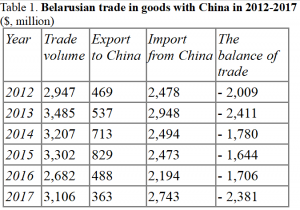Skyrocketing economic growth and weak regional development – digest of the Belarusian economy

On 16 March 2018, the official statistical body of Belarus Belstat has announced that GDP growth in the first two month of the year has accelerated.
Meantime, the weak regional development cast doubt on the sustainability of Belarusian economic growth in the future. Decreasing population number, lack of investment, and depressed business climate accompanied by low average wages play here a crucial role.
Finally, on 20 March 2018, the President of Belarus Alexander Lukashenka has announced plans for the establishment of a new ministry – The Ministry of Digital Economy. The digital transformation of the economy needs authorized governance.
Economic growth: Shifting to the fifth gear
According to Belstat, in January-February 2018 the GDP growth reached 5.6 per cent year-on-year. The industrial production has increased by 10.3 per cent and exports of goods by huge 36.5 per cent (in January). Finally, during the first two months of 2018 investment in fixed capital has increased by 24.8 per cent year-on-year.
The current positive economic figures ground on several factors. First, the world oil prices increased during the previous year. Second, because of administrative stimulus real wage growth accelerated, which led to the expansion of consumer demand.
Third, because of first two factors, the economic mood of economic agents significantly improved. Firms expect more orders, hire more workers, and actively lend and invest. Households, hoping for more income in the future, actively take loans, increasing current consumption. Banks began to lend more actively while continuing to reduce credit rates.
These positive shocks warmed up domestic demand. In addition to domestic demand, new shocks spurred external demand (for example, Russian demand for Belarusian exports began to grow due to increased growth in Russia amid more expensive oil).
Meanwhile, because of active administrative policy, the real wage growth since the 4th quarter of the last year was about 30 per cent. This giant increase gave rise to a wave of consumer optimism and demand but also produced a negative impact on price stability, the dynamics of the exchange rate, the fiscal balance, competitiveness, and profitability of Belarusian firms.
In the case that the authorities in the future will not abandon the artificial stimulus of wages, these negative effects will continue to grow, turning into a full-blown threat to price and external stability of the Belarusian economy.
Regional development: Weak performance
Meanwhile, the steady decline of the district Belarusian population in general and its working-age part, in particular, reveals crisis tendencies in the regional development. According to Belstat, the district’s population of Belarus constantly decreases and in comparison with the beginning of the century its number shrank by almost a quarter (see Figure 1), contrary to the urban population of large cities that increased by approximately 9 per cent.
Moreover, the official statistics reveal even more negative trend for the district’s working-age population. During last two decades, its number steadily declined by 1.4 per cent each year and in the last few years its reduction even amplified. All these mean that rural life loses its attractiveness to both adult and young Belarusians.

One of the key reasons stays the significant difference in wages between districts and large cities. The average salary in districts constitutes approximately 78 per cent of the average salary in major cities of Belarus.
The dynamics of entrepreneurial activity in the districts adds additional pain. In particular, over the past three years, the number of micro and small organizations has decreased by 5 per cent (Figure 2). At the same time, the additional development of small business in rural areas possesses potential sources for regional economic growth and, first of all, in agribusiness.

Additionally, Belarusian districts significantly lag behind in attracting foreign direct investment (FDI) that represent a major source of new technologies and create a potential for export diversification of regional goods. For example, during 2005-2015, districts on average attracted 4.6 times less FDI per capita than the major cities of Belarus.
IT sector: Building a new regulator
On 20 March 2018, Alexander Lukashenka has announced plans for the establishment of the Ministry of Digital Economy that will bring the entire domestic economy on the digital platform.
According to Alyaksandr Kurbatski, a member of the Council established for the development of the digital economy in Belarus, IT would penetrate into all sectors of the economy. Now virtually any sphere of human activity affects digitalization and this process really needs to be managed and coordinated somehow.
The creation of a new Ministry fully fits into the ambitious task of the authorities to turn Belarus into an IT-country, reorienting the Belarusian IT-sector to a product model. The government expects that this will significantly increase the value added and increase the level of technological equipment.
However, the long-run consequences of this project still stay unclear. The expectations of long-term positive effect ground on the fact that any progress in improving the level of technical equipment and the integration of Belarusian firms into the global chains will add additional benefits to the country.
On the other hand, additional benefits and preferences for the IT-companies may exceed effects obtained. Moreover, the focus on sectoral preferences may adversely affect the transparency and competitiveness of the business environment.
In the short term, the decree may have a beneficial effect, but only in the form of capital inflows to the country’s IT sector.
Taking all together, the skyrocketing economic growth of the first two months of the year added optimism to the whole economy, however slow progress in the regional development cast doubt on its long-run sustainability.
Aleh Mazol, Belarusian Economic Research and Outreach Center (BEROC)
This article is a part of a joint project between Belarus Digest and Belarusian Economic Research and Outreach Center (BEROC)





 To make things worse, since the
To make things worse, since the 


